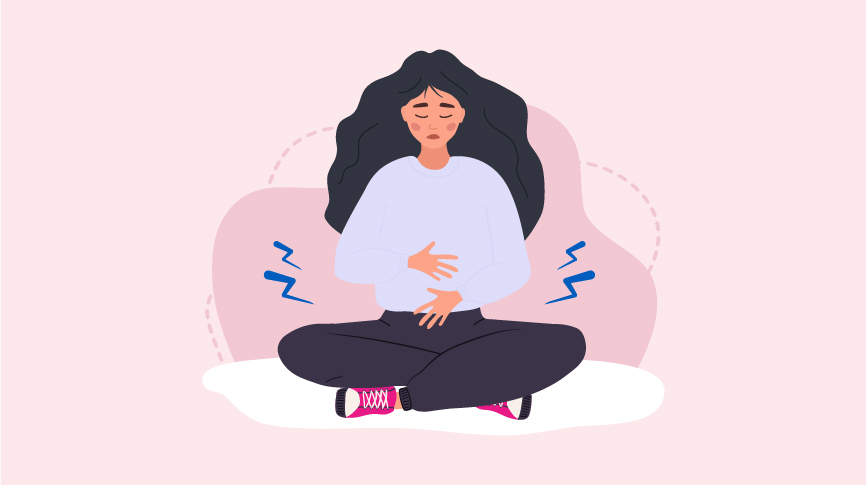Why Do I Have Cramps But No Period?

Sometimes called phantom periods or ghost periods, this scenario occurs when a person may have period symptoms — like cramping, pelvic pain, breakouts, or bloating — but no actual blood is released.
So, what causes this curious phenomenon? It may be a variety of factors stemming from a regular part of your menstrual cycle or a symptom of an underlying health issue. Not sure where you fit in? We’re here to clear up some worries and offer some reasons for why your monthly flow is missing in action.
Normal ovulation
The pain occurring midway through your cycle with no blood could be something called “mittelschmerz,” which is caused by the ovary that is releasing the egg. Mittelschmerz usually begins 10 to 14 days before your period.
This dull, sharp pain is typically on one side of the lower abdomen, which depends on which ovary releases the egg, and can last anywhere from a few minutes to a few days. It may also be mistaken for appendicitis since it typically occurs on one side of the body.
According to StatPearls, mittelschmerz affects over 40% of women regularly each month.
Ovarian cyst
A cyst is a sac of fluid that can form on the ovaries. Even though most ovarian cysts are asymptomatic, they can cause pelvic pain if they have ruptured or have grown in size.
Although it is rare, the pain from a ruptured cyst is sudden and sharp whereas a cyst that has grown larger may be a dull pain.
Some people may mistake this pain as period cramping since it causes bloating and swelling as well.
About 10 out of 100 women have an ovarian cyst, according to the National Library of Medicine, which can range in sizes from a cherry to a grapefruit.
Endometriosis
When endometrial tissue grows on the outside of the uterus, the pain that follows may be similar to period cramping. This chronic condition, which affects 11 percent of people between the ages of 15 to 44, may be seldom painful or may last throughout the entire month.
Some people feel cramping in their lower back and belly button as well. Other symptoms of endometriosis are pain during sex and painful bowel movements.
If left untreated, those with endometriosis may have a difficult time conceiving.
Treatments for endometriosis include oral contraceptives, progestins, and over-the-counter medications while advanced endometriosis requires surgery to remove the endometrial tissue.
Pregnancy
If you have cramping but no period, there is a possibility you may be pregnant. When a baby is growing inside of you, the pain is the fetus attaching to the womb, and is something called “implantation pain.”
You may feel cramps four weeks into the pregnancy, which may sync up with your regular period. However, there are ways for you to differentiate this pain from cramping. Implantation pain has been described as “prickling,” “pulling,” or a “tingling feeling.”
Take a pregnancy test to make sure since early pregnancy symptoms are similar to premenstrual symptoms.
Ectopic pregnancy
This is a life threatening condition when a fertilized egg grows in one of the two fallopian tubes instead of attaching to the lining of the womb. It is the leading cause of maternal mortality in the first trimester, according to the American Academy of Family Physicians.
Sometimes, ectopic pregnancies can occur elsewhere in the body, too, like the ovary, abdominal cavity, or cervix.
The fertilized egg cannot survive when attached to any of these areas and if it’s growing in the fallopian tube, it may rupture if left untreated and cause the mother to go into shock.
The cramping will feel mild on one side of the belly. However, the pain will grow to a sharper pain that can be felt in the lower back and shoulders. Some people may have typical premenstrual symptoms like nausea and sore breasts as well.
Digestion
Sometimes, pelvic pain may not even be related to your pelvic region. Pain in the lower abdomen may be related to digestion issues, like inflammatory bowel syndrome (IBS), or even constipation.
If you have diarrhea, an urge to pass a bowel movement, fever, or blood in your bowel movement along with cramping, you may have IBS, which 20 percent of people in the United States have. Women who are under 50 years old are more likely to have the condition, making it easily misdiagnosed for women who haven’t reached menopause yet.
While there is no cure for IBS, changes to your diet and over-the-counter medications can help alleviate the discomfort.
Ovarian Cancer
Ovarian cancer is the fifth most deadly cancer for women, with statistics showing that women have a one in 78 risk of being diagnosed with the cancer in their lifetime.
Cramps associated with ovarian cancer are mild and can easily be written off as constipation, giving it the nickname the “silent killer,” due to the lack of symptoms. However, if the pressure and pain doesn’t go away, this could be something more nefarious than bowel or digestion issues.
Another symptom is belly swelling and bloating, with a frequent need to urinate.
While ovarian cancer is more common in women 63 years old or older, it doesn’t mean younger women are totally safe from a diagnosis.
If you’ve been diagnosed with breast cancer, have a history of cancer, are Eastern European or of Ashkenazi Jewish background, have endometriosis, started menstruating early, or had miscarriages, you may be at higher risk for ovarian cancer.
How to diagnose cramps with no bleeding
If your cramps are persistent, contact your doctor for immediate assistance, especially if the cramping gets worse or appears suddenly.
Your doctor may provide a pelvic exam, ultrasound, or laparoscopy to examine the uterus and ovaries more accurately in order to weed out underlying medical conditions like ovarian cancer or ectopic pregnancy.
However, in most cases, having cramps with no flow is nothing to be worried about. Try to ease cramping pain by taking a warm bath, using a heating pad on your abdomen, drinking warm beverages like tea, and taking nonsteroidal anti-inflammatory drugs (NSAIDs) like aspirin and ibuprofen.

S. Nicole Lane is an editor and journalist living on the South Side of Chicago.


